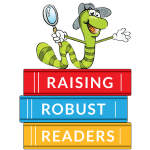How we went from trying to find the best way to teach a child with Down syndrome to learn how to read to creating Wordy Worm and the Raising Robust Readers reading program.
After many years of struggling with trying to find a way to teach her son, who has Down syndrome, learn how to read, Judy O'Halloran met a retired learning disabilities teacher who showed her the world of phonograms. Judy taught her longtime friend, Marilee Senior, what she learned. Marilee, who struggled as a child learning to read due to dyslexia, saw how discovering the code and the sounds of phonograms made reading so much easier for those struggling to learn. Together, they set about using Judy's academic knowledge and Marilee's creativity to bring Wordy Worm and the Raising Robust Readers program to life!
"My son Casey is the genesis of our program."
Judy O'Halloran, Co-Developer of Raising Robust Readers
As an avid reader, English teacher, reading tutor, and mother, reading – and learning to read– has always been important to me! When our youngest son, Casey, who has Down syndrome, was going through school, the typical reading programs were not effective in teaching him to read. So I took extra college reading courses, reading workshops and in- service programs in an effort to find what would work. Finally, learning and understanding phonograms –the single letter and multi-letter combinations that represent the smallest sounds in words– provided Casey with the quantum leap in learning to read.
Later, when our oldest granddaughter turned three, I started to teach her the phonograms. Children are such miracles, so eager to learn. Their minds, like the proverbial sponge, soak up so much.
The method I had learned for teaching phonograms was not particularly engaging. And while I had used additional creative exercises of my own, I wanted a more systematically playful approach to introducing them. Enter my friend, fellow grandmother, and creative artist, Marilee.
-Judy
"As a child, I struggled with reading."
Marilee Senior, Co-Developer of Raising Robust Readers
I remember when Judy mentioned to me that she had started teaching Katelyn the phonograms. She explained, “If young children can tell you that a cow says, ‘moo,’ then they can tell you that m says /mmm/. “
I wanted to start teaching them to my 3- year-old granddaughter as well. But I didn’t know how. As a child, I had not been taught phonics beyond the sounds of the alphabet. I found learning to read, using basic phonics, confusing and frustrating. I am blessed with a great memory. However, learning to memorize 200,000 words to become a proficient reader proved to be rather challenging. In fact, this was the very reason I wanted to be sure Summer learned this very systematic code. I knew it would give her the added confidence and solid foundation so important in learning to read.
I started by looking at typical phonogram flashcards and listening to their sounds. I couldn't imagine children sitting through something so boring. and I wanted to find an easier way to learn them. I can remember every poem my mother ever wrote and I thought putting them to song and rhyme would make them much easier to learn. When I sat in on Judy's tutoring sessions, she always added visual clues and gestures to help retention. So we sat down together and combined our skills to make learning phonograms easy to learn and fun to teach.
-Marilee

"The reading detectives brought me to life to make it fun for everyone."
Wordy Worm
When Marilee (Mino) and Judy (Omi) first started working with their granddaughters, they took photographs of Summer and Katelyn, and their younger granddaughters, Sydney, Caroline, and Cameron acting out the phonograms. They used the pictures to illustrate phonogram cards which helped the girls to learn. They wrote books, made up games, and went on phonogram hunts all around town.
One day Judy met a friend who was Casey’s first principal and later became director for staff development for the school district. When she heard about their reading activities, she said, “You have a moral obligation to share this with other children.” Judy’s first reaction was, “Please don’t tell me I have a moral obligation to do that. I’m Catholic. I’ll have to do it. And that’s not what I planned on doing.”
Marilee thought it was a good idea to share all they had researched and developed because, for her, learning the phonograms was like discovering a code. All the things she could have learned as a child about reading and spelling was so simple after all. So she put her creativity to work, imagining a little friend that would help children learn and remember. With that, the reading detectives brought ME to life–to make it fun for everyone. Now I help teach the rhymes and gestures. I can show you how to read on the go wherever you go. I make teaching easy and learning fun. I hope you’ll join us.
-Wordy

